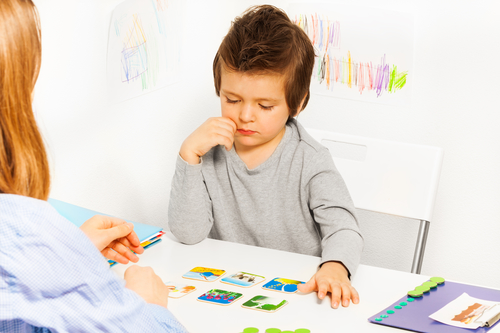
On the Spectrum: How to Support Autistic Students
 According to the advocacy organization Autism Speaks, there is a difference between “normal time” and “Autism time.” “Autism time” is defined as “twice as much time, half as much done.” This is not meant as a slight towards students with Autism, but rather as a reminder that we have to educate ourselves and adapt our behavior in order to best support these students and understand their life experience. Working with Autistic students on our “normal time” schedule can, for instance, lead to impatience and lack of empathy on our part, which will negatively affect the students. How can we best support young people who essentially live a different existence than we do? Autistic students, for example, are more prone to being bullied, less adaptable to changes in learning environments, and more likely to have tantrums or meltdowns when there is uncertainty in the classroom. Based on the Individuals with Disabilities Act of 1975, all students are entitled to a “free and appropriate education.” But how do we follow this rather vague guideline and put it into successful practice when working with the three million children affected by Autism Spectrum Disorder?
According to the advocacy organization Autism Speaks, there is a difference between “normal time” and “Autism time.” “Autism time” is defined as “twice as much time, half as much done.” This is not meant as a slight towards students with Autism, but rather as a reminder that we have to educate ourselves and adapt our behavior in order to best support these students and understand their life experience. Working with Autistic students on our “normal time” schedule can, for instance, lead to impatience and lack of empathy on our part, which will negatively affect the students. How can we best support young people who essentially live a different existence than we do? Autistic students, for example, are more prone to being bullied, less adaptable to changes in learning environments, and more likely to have tantrums or meltdowns when there is uncertainty in the classroom. Based on the Individuals with Disabilities Act of 1975, all students are entitled to a “free and appropriate education.” But how do we follow this rather vague guideline and put it into successful practice when working with the three million children affected by Autism Spectrum Disorder?
Ask What Your School Can Do For You
Under that umbrella of “free and appropriate education” fall special accommodations personally tailored for Autistic students. Individualized Education Programs (IEPs) are essential for success. Think of an IEP as a student’s “road map” to guide him through school. Within this map should be answers to questions such as:
- What special support will the student have in the classroom (aides, tutors, specialized equipment, etc.)
- Will the student be in a mainstream classroom or in a special education class, and which environment will suit him better?
- What other specific services (transportation, afterschool programs, etc.) should the student have access to?
The IEP meeting should include school professions such as psychologists, teachers, and counselors to find the best program for the student. The IEP creates a “road map” that can allow families to feel confident that their child gets the best and most appropriate accommodations to create a positive learning experience. You can download a school/community tool kit to help with this process here: https://www.autismspeaks.org//family-services/tool-kits/school-community-tool-kit
Educate Others
Everyone has heard the word “Autism,” but does everyone really know what it means, how it affects behavior, and how to handle it in a supportive way? It is important that families of Autistic children act as advocates and educators. For instance, many people may not understand the extent of the social deficits that exist in those with Autism. Explaining the situation to peers, other parents, teachers, and others involved in the student’s life can go a long way toward easing the student’s educational and social experience. Children with Autism, for instance, are not always able to tell the difference between playful and mean-spirited teasing. Educating the community about these types of developmental delays can limit misunderstandings and promote awareness, which will lead to less difficulties for the student. You can find a helpful FAQ that can be shared with people in the child’s circle here: https://www.autismspeaks.org/what-autism
Find Support Systems Outside of School
School can be extremely stressful for students on the Autism spectrum. Luckily, there are many outside programs that cater to this population. Surrounding the child with others who are also on the spectrum, or who have other developmental delays, can create a “circle of friends” that can prove invaluable for helping the child integrate successfully into otherwise difficult social situations. Many of these programs offer a “safe place” for children and can foster positive social interactions under the guidance of qualified mental health professionals. From art therapy to body movement, the activities that these programs offer can provide many different types of support that can make the Autistic child’s day-to-day experience easier. Ask your child’s school to recommend programs within the community, or see if pediatricians, psychologists, or other parents can refer you to appropriate programs. Additionally, you can use the internet to help locate support systems: https://www.autismspeaks.org/science/resources-programs
Patience, Empathy, and Positive Reinforcement
Developmentally, Autistic students are “younger” than their age indicates. A fifteen year-old on the spectrum, for instance, may function socially and behaviorally at an eight or nine year-old level. In hectic school and classroom settings, it can be easy to become impatient with these lagging behaviors and responses. Practicing patience with these students is vital in making them as comfortable in their environment as possible. Understanding that seemingly trivial changes in things such as classroom configuration, odors, or lighting can trigger Autistic students, can help us to understand their reactions and allow us to help them work toward more appropriate responses. Becoming angry, impatient, or being punitive will only make the experience tougher on the child. Similarly, responding to these children empathically is hugely important: the more support they feel they are getting, the more likely they are to adapt well to situations. If they mess up, don’t react harshly; rather, model the proper behavior, allow them to try again, and give positive feedback when they display appropriate social interactions. Often, it’s us, not them, who need to make changes in order to foster a supportive environment. We may need to consider changing the classroom environment to reduce stress or altering our own reactions to provide the best chance for growth and success for Autistic students.
As with many “disorders,” Autism is subject to many myths and generalizations. With approximately 1 in 65 children affected by Autism Spectrum Disorder, it is now more important than ever that we are, in fact, creating a “free and appropriate” educational and social experience for these students. We can do this by educating ourselves and our communities, locating and utilizing outside programs and resources, and remembering to stay patient, positive, and empathic.
Written by Phil Lane
Contact us today to learn more about how our tutors can help your child this fall!



